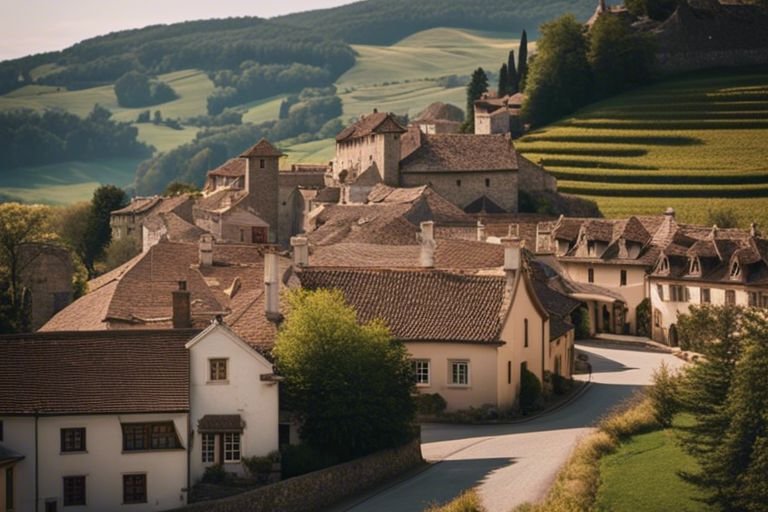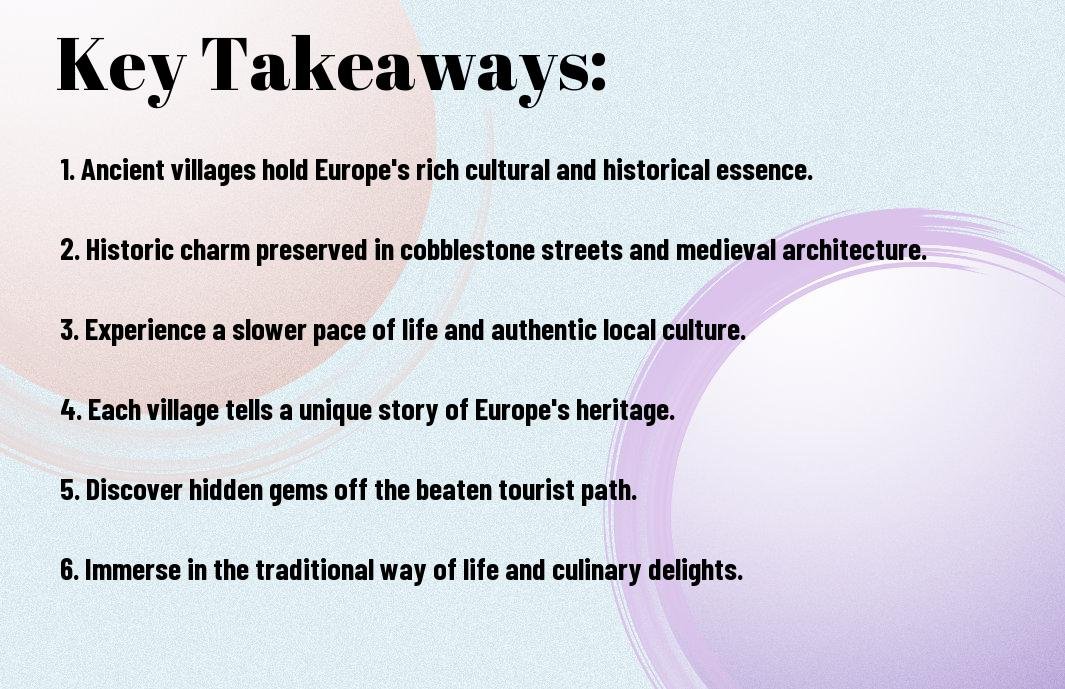
It’s time to probe into Europe’s rich cultural heritage by exploring its ancient villages. These charming, historic settlements offer a glimpse into the continent’s heart and soul, providing a unique perspective on its past and present. You can genuinely connect with Europe’s essence by immersing yourself in the cobblestone streets, centuries-old architecture, and traditional way of life in these enchanting villages.
For those eager to begin this cultural journey, consider joining Brown Travelers: Upcoming Trips for an unforgettable experience of exploration, discovery, and enlightenment.

Key Takeaways:
- Preservation of History: Ancient European villages offer a glimpse into the continent’s rich history and cultural heritage.
- Authentic Experiences: Visiting these villages allows travelers to immerse themselves in the local way of life.
- Connection to Nature: Many of these villages are nestled in breathtaking natural surroundings, allowing visitors to connect with the soul of Europe through its landscapes.

The Charm of the British Countryside
Some of Europe’s most picturesque and enchanting villages can be found nestled in the British countryside. Steeped in history and teeming with quaint charm, these villages offer a glimpse into a bygone era, where cobblestone streets wind their way through rolling hills and ancient stone cottages exude a sense of timeless beauty.
The Cotswolds: Timeless Beauty in Stone
Cotswolds is a region in south-central England known for its idyllic villages with honey-colored stone houses, thatched roofs, and lush green landscapes. One of the most charming aspects of the Cotswolds is its well-preserved architecture, dating back to the medieval period. Visitors to villages like Bourton-on-the-Water, Broadway, and Castle Combe can stroll through streets lined with centuries-old buildings, visit historic churches, and explore quaint shops and tearooms that add to the region’s undeniable allure.
Scottish Hamlets: A Legacy of Clans and Traditions
The Scottish countryside is dotted with hamlets that glimpse Scotland’s rich history and cultural heritage. These small villages, nestled amidst dramatic landscapes of rugged mountains and misty lochs, embody the spirit of Scotland’s past, where clans once ruled and traditions ran deep. A visit to villages like Inveraray, Dunkeld, and Plockton reveals a world where ancient castles stand sentinel and traditional tartan patterns still adorn the locals, showcasing the enduring legacy of Scottish heritage.
France’s Hidden Gems
After exploring the charming countryside of France, it becomes evident that the real soul of the country lies within its ancient villages. These picturesque settlements offer a glimpse into the rich history and culture that have shaped the French countryside over the centuries.
Provencal Villages: The Heart of the French Rural Dream
The Provencal villages of southern France epitomize the French rural dream. With their cobblestone streets, pastel-colored houses, and blooming flower boxes, these villages exude a sense of tranquility and charm that is hard to find elsewhere. Visitors can wander through narrow alleyways, admire Romanesque churches, and savor the flavors of local cuisine in quaint cafes.
The Bastides: Medieval New Towns of Southern France
Provencal villages may steal the spotlight, but the Bastides of southern France offer a different kind of charm. These medieval new towns were strategically built in the 13th and 14th centuries to promote commerce and trade. Characterized by their grid layout and central square, the Bastides showcase a unique blend of medieval architecture and urban planning.
Southern France’s Bastides may not be as well-known as their Provencal counterparts, but they offer a fascinating glimpse into the region’s medieval history. Visitors can still see remnants of the fortified walls that once surrounded these towns and impressive market halls where merchants once traded their goods.
The Italian Village Tapestry
To unveil Europe’s soul, one must venture into the ancient villages scattered across the Italian countryside. These villages, each with unique charm and history, offer a glimpse into the rich tapestry of culture woven through the centuries. From the rolling hills of Tuscany to the whitewashed walls of Puglia, exploring these villages is like stepping back in time to a world where art and architecture intertwine seamlessly.
Tuscany’s Hilltop Villages: A Synthesis of Art and Agriculture
On the picturesque hills of Tuscany, time seems to stand still as you wander through the cobblestone streets of medieval villages like San Gimignano, Montepulciano, and Volterra. These villages, perched high above the vineyards and olive groves, are a testament to the region’s agricultural heritage and showcase a remarkable display of art and architecture. From frescoed churches to elaborate palazzos, every corner of these villages tells a story of a bygone era when artisans and farmers worked hand in hand to create a harmonious way of life.
The Trulli of Puglia: A Unique Confluence of History and Architecture
Architecture enthusiasts will be captivated by the unique cone-shaped dwellings known as trulli that dot the landscape of Puglia. These traditional limestone structures, with thwhitewashedshed wawhitewashedical roofs, are a testament to the region’s ancient history and the ingenuity of its people. With their wh whitewashedystery and charm, the trulli offer a glimpse into a past where simplicity and functionality converged to create truly unique homes that have stood the test of time.
On the outskirts of Alberobello, a UNESCO World Heritage site, visitors can immerse themselves in the enchanting world of the trulli by staying in one of these traditional dwellings turned into cozy accommodations. This immersive experience allows travelers to connect with the roots of Puglian culture and gain a deeper appreciation for the craftsmanship and history encapsulated in every stone of these iconic structures.
The Iberian Echoes
Many ancient European villages hold a unique charm that reflects the essence of the continent’s rich history. This essence is powerful in Spain and Portugal, with echoes of the Iberian Peninsula’s diverse cultural influences resonating through its quaint villages’ cobblestone streets whitewashedshed shed buildings.
White Villages of Andalusia: Moorish Influences and Spanish Culture
Onewhitewashedt captivating spectacles in Southern Spain is the collection of White Villages that dot the Andalusian countryside. These picturesque villages, known locally as “Pueblos Blancos,” are characterized by whitewashed houses, whitewashed, and stunning views of the surrounding landscapes. The architectural style of thewhitewashedreflects a unique blend of Moorish influences from the region’s Islamic past and traditional Spanish culture.
The Galician Horreos: Granaries of the Soul
The Galician horrors are a fascinating feature of the rural landscape in the northwestern region of Spain. These elevated granaries, built with stone pillars and wooden structures, serve as storage spaces for crops, keeping them safe from moisture and rodents. The horreos’ design is practical and aesthetically pleasing, with intricate carvings and unique architectural details that reflect the region’s Celtic and Roman heritage.
The Galician horrors are not just functional structures; they symbolize the region’s agricultural traditions and close connection to the land. These granaries are an integral part of Galician culture and identity, representing the resilience and resourcefulness of its people.
Another
The Spirit of Germanic Hamlets
Once again, exploring the ancient villages of Europe offers a glimpse into the rich cultural heritage that has shaped the continent. The Germanic hamlets scattered across the countryside are steeped in tradition and charm, reflecting a way of life that has endured for centuries.
Bavarian Villages: A Blend of Tradition and Natural Beauty
Blend the picturesque landscapes of the Bavarian villages with the warmth of traditional German hospitality, and you have a recipe for a truly enchanting experience. Nestled amidst rolling hills and lush forests, these villages exude a sense of tranquility and timelessness. The half-timbered houses and cobblestone streets add to the old-world charm, while the sound of church bells ringing in the distance only enhances the overall ambiance.
The Alsatian Wine Route: Where Culture and Viticulture Meet
One cannot talk about the Alsatian Wine Route without mentioning its unique blend of culture and viticulture. Stretching across picturesque villages and vineyard-covered hillsides, this route offers a feast for the senses and a deep explore the region’s rich heritage. Visitors can sample renowned Alsatian wines, explore charming villages with pastel-colored houses, and immerse themselves in the local art, music, and cuisine.
Culture is at the heart of the Alsatian Wine Route experience, with each village along the way telling its own story of tradition and craftsmanship. The meticulous grape cultivation practices, the centuries-old winemaking techniques, and the festive wine festivals all come together to create an atmosphere that is as captivating as it is enriching.
Slavic Village Traditions
For a deep look into the fascinating traditions of Slavic villages, one must first understand the rich history that shaped them. An imperative read on this subject is The Discovery of the Individual in Renaissance Europe, which explores the evolution of individual identity in Europe and its influence on village life.
The Wooden Architectures of Poland and Russia
To truly appreciate the charm and heritage of Slavic villages, one must explore the wooden architecture of Poland and Russia. These structures, with their intricate carvings and unique designs, are a sight to behold and a testament to the craftsmanship and resilience of the people. These villages’ wooden churches, houses, and barns have stood the test of time, embodying a sense of history and tradition deeply ingrained in Slavic culture.
Balkan Villages: Crossroads of Civilizations
On the crossroads of civilizations, Balkan villages offer a glimpse into a melting pot of diverse influences and traditions. Nestled amidst stunning landscapes, these villages have witnessed the ebb and flow of various cultures, leaving behind a rich tapestry of architecture, art, and customs. The harmonious blend of Eastern and Western influences in Balkan villages truly reflects the region’s tumultuous yet fascinating history.
Slavic village traditions encompass many cultural practices, from ancient folklore and superstitions to vibrant celebrations and ceremonies. These villages are not just repositories of history but also living, breathing communities that continue to safeguard age-old traditions while embracing modernity. Exploring Slavic villages is a journey through time, a chance to discover the soul of Europe in its most authentic form.
The Nordic Heritage
Norwegian Fjord Villages: Where Nature Meets Norse History
The Norwegian fjord villages are breathtaking as they nestle in the rugged landscapes of Norway, where nature meets Norse history. The deep blue waters of the fjords contrasted against the steep mountains create a picture-perfect, serene, and awe-inspiring setting.
The architecture of the villages reflects the heritage and way of life of the Norse people who settled in these regions long ago. With wooden houses painted in traditional colors and fishing boats lining the shores, each village tells a story of resilience and unity with nature.
The Finnish Wooden Towns: A Saga Written in Timber
An imperative part of Nordic heritage, the Finnish wooden towns are a living saga written in timber. Towns such as Porvoo and Rauma have preserved their historic wooden architecture dating back to medieval times, offering a glimpse into Finland’s past.
The towns are a visual delight and a testimony to Finnish craftsmanship. Their intricate carvings and well-preserved structures transport visitors back in time. Strolling through the narrow streets lined with colorful wooden houses, one can’t help but feel their timeless charm.
Norwegian fjord villages and Finnish wooden towns are beautiful destinations and windows into the Nordic countries’ soul, where history, nature, and craftsmanship converge to create an unforgettable experience.
Concluding Reflections
Lessons Learned from Europe’s Living Museums
Not just repositories of history, Europe’s ancient villages serve as living testaments to a bygone era. These villages have taught us the value of preservation, resilience, and community. They remind us of the importance of honoring our past while embracing progress. As we wander through cobblestone streets and centuries-old buildings, we are reminded of the enduring spirit of the European people and their connection to the land.
Preserving the Spirit of the Villages for Future Generations
For generations, these villages have stood as beacons of culture and tradition. It is our responsibility to safeguard these treasures for the future. The charm and authenticity of these villages must be preserved to ensure that future generations can experience the same sense of wonder and awe that we feel today. By investing in sustainable tourism practices, supporting local artisans, and implementing conservation efforts, we can ensure these villages continue to thrive for centuries.
Generations to come will benefit greatly from experiencing the rich history and unique charm of Europe’s ancient villages. By immersing themselves in these villages’ customs, architecture, and way of life, future travelers will gain a deeper appreciation for European heritage and culture. Through the preservation of these villages, we can pass down a piece of history to inspire and educate generations yet to come.
Reflections: Europe’s ancient villages offer a glimpse into the continent’s soul, showcasing its rich history and cultural heritage. The lessons learned from these living museums are invaluable, reminding us of the importance of preservation and community. By preserving the spirit of these villages for future generations, we can ensure that their legacy endures for years to come.
FAQ
Q: What is the significance of ancient villages in Europe?
A: Ancient villages in Europe hold the key to unraveling the continent’s rich historical and cultural tapestry. These villages offer insights into traditional architecture, local customs, and the way of life of past generations.
Q: How can exploring ancient villages help discover the soul of Europe?
A: Exploring ancient villages allows one to immerse themselves in Europe’s authentic charm and heritage. These villages provide a glimpse into Europe’s soul by showcasing its deep-rooted traditions, stories, and the enduring spirit of its people.
Q: What are some must-visit ancient villages in Europe for soulful exploration?
A: Some must-visit ancient European villages include Bibury in England, Hallstatt in Austria, Rocamadour in France, and Civita di Bagnoregio in Italy. These villages offer a unique blend of history, art, and culture that provide a truly enriching experience for those seeking to discover the soul of Europe.



